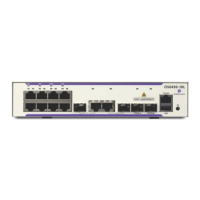Configuring MAC Retention Configuring MAC Retention
page 9-6 OmniSwitch AOS Release 6 Network Configuration Guide July 2010
Configuring MAC Retention
This section describes how to use Alcatel-Lucent’s Command Line Interface (CLI) commands to
configure MAC Retention.
Enabling MAC Retention
MAC Retention is disabled on the switch by default. If necessary, use the mac-retention status command
to enable MAC retention. For example:
-> mac-retention status enable
To disable MAC Retention on the switch, enter the following:
-> mac-retention status disable
Note. When the administrative status of MAC retention is enabled, the stack performance is enhanced.
Detecting a Duplicate MAC Address
After a takeover, if the former primary switch does not return to the stack after the preset time interval has
elapsed, MAC address duplication may occur. To alert the administrator of a possible MAC address
duplication, the switch can be configured to generate an SNMP trap.
You can enable the switch to generate an SNMP trap by using the mac-retention dup-mac-trap
command as shown:
-> mac-retention dup-mac-trap enable
To disable SNMP trap generation, enter the following:
-> mac-retention dup-mac-trap disable
Configuring MAC Release
After multiple takeovers, the switch can be allowed to release the retained MAC address. This enables the
stack to obtain a new stack address from the EEPROM of the current primary element.
To release the retained MAC address from a switch, use the mac release command as shown:
-> mac release
Note. A switch will not be allowed to release the MAC address derived from its EEPROM.
To view the MAC Retention status, use the show mac-retention status command as shown:
-> show mac-retention status

